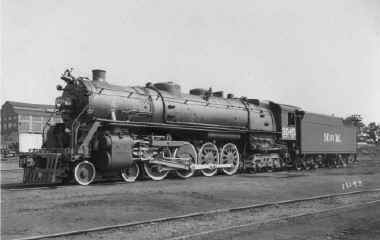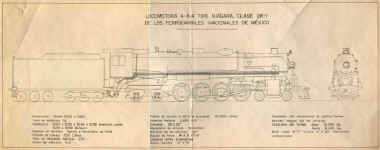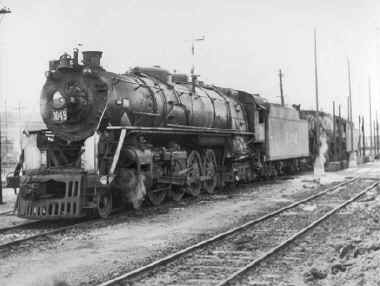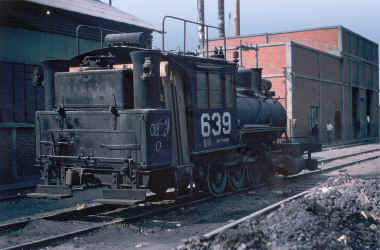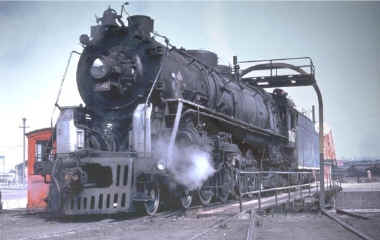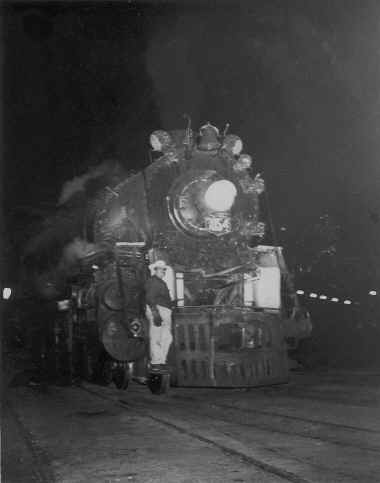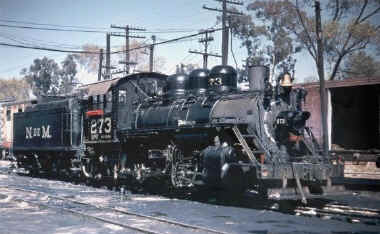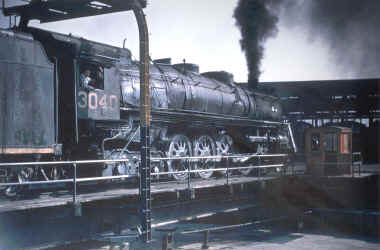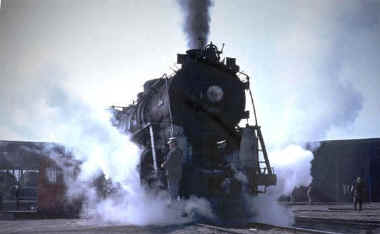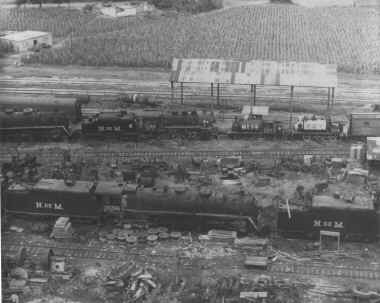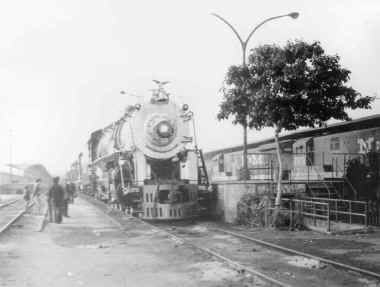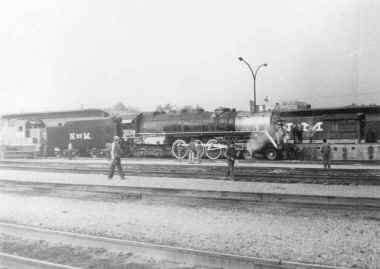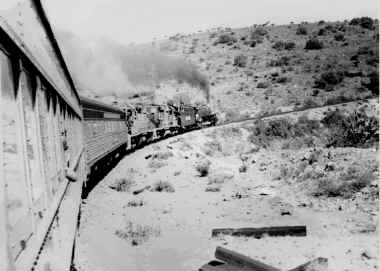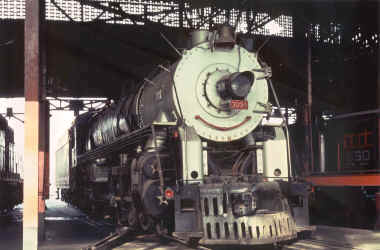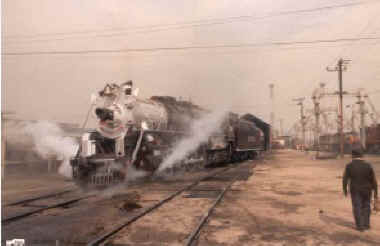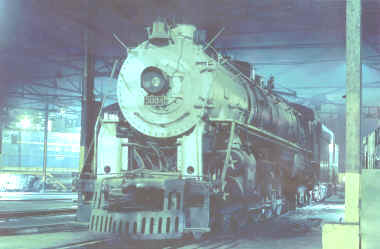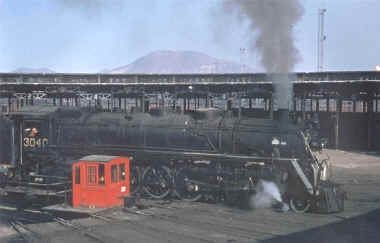|
||
Valle de Mexico --- Valley of Memories |
||
|
story by Sammy King |
Almost 38 years have passed since my first trip to Mexico City, half of which was described as part of my story on the Ferrocarril Interoceanico. The rest of my visit was spent observing and photographing the remaining active Nacionales de Mexico Niagara locomotives based at the modern 32 stall roundhouse at Terminal Valle de Mexico. A lot of guys my age or just a little older went down there and saw these engines, and every one of them I've talked to has at least one interesting story or photograph. We all agree that real railroading has been over for a long, long time.
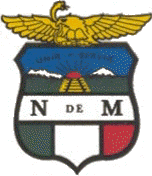 |
|
FERROCARRILES |
Back then in 1966, I thought nothing of the F units and E units and ALCOs, passenger trains, cabooses and 40 foot boxcars that were the norm in the USA. Some wooden cars were still in interchange service, refrigerator cars with ICE HATCHES, even wooden stock cars. A fair amount of heavyweight passenger equipment was still in use, too, along with Pullmans and dining cars. About the only American steam engines I can ever recall in genuine revenue service were in Louisiana on the Illinois Central, and one early morning encounter with a woodburner on the Louisiana Long Leaf Lumber Co. On family vacations I would see the last few locomotives in park displays, while the last few steam shops were either converted to diesel service or abandoned altogether. Other than dieselization, US railroading was still pretty much like it was during the WW II period. To really see what it had been like back then, it was necessary to go to Mexico, where the last mainline steam power in North America was still working 24/7.
The same letter which granted permission to enter the San Lazaro terminal was also in effect for the standard gauge yards north of Mexico City at Valle de Mexico, which were actually part of one operating district reaching all the way to the modern Buenavista passenger station in downtown. Part of the letter granted permission to ride the employee shuttle bus from Buenavista out to the yard office, saving lots of time and carfare, not to mention that Joe and I couldn't speak 10 words of Spanish between us. Of course I'd had it in school, but didn't learn much.
The sun still hadn't come out when we reached the yards. Getting off the bus, we picked our way through the fog and drizzle along the path from the yard office to the roundhouse, gingerly climbing and descending the wet, slippery stairs crossing the busy hump and departure tracks. The first sign that there might be steam engines working there was the telltale trails of grease, oil, and water dribbled all along the tracks, unlike those I knew in the USA. By any standard Valle de Mexico is a giant roundhouse, and it appears even bigger from it's vast, spread out backside. As we got closer I could see a few smudges of smoke, then the turntable, then the backs of at least a dozen tenders framed by their stalls in the roundhouse. A couple of strange looking tank engines sat outside, but I still didn't see any action.
|
NdeM 3049-3029 This was what I saw when I walked around the corner of the sandhouse, looking for action. By this time, the QR-1's were mostly greasy and grubby, but had received cross compound air compressors and carried various little personal touches added by their crews. A frequent example was the custom made shields attached to the headlight brackets of some Niagaras -- Sometimes this wasn't done just for adornment, as the original number plate had to be removed first. Both of these beautiful machines were not long for this world. All photos by Sammy King except as noted. |
The place was gigantic. There had to be at least half a dozen tracks feeding the turntable. Peeking out from between two sheds were part of a set of drivers and some greasy rods. A few seconds later I walked around the corner of the sandhouse, and THERE THEY WERE !!! Two hot 4-8-4s, numbers 3049 and 3029, stood nearly coupled up on the arrival track, swathed in steam. There didn't seem to be anybody around, but pretty soon the hostlers appeared out of nowhere and went to work. The air pumps started chugging, the blowers started hissing, the fires were bumped up, and injectors started. There was just enough time to look the engines over good and shoot a few pictures before the 3049 whistled off and started creeping toward the turntable.
We usually think of narrow gauge railroads as being friendlier and more accessible for non-employees, railfan photographers, and pests like myself. This time it wasn't that way, as I never rode a Mexican narrow gauge engine until visiting the Ferrocarril Interoceanico in 1986. Anyhow, it didn't take very long before I was riding in 3049's cab, then on top of her tender. She shuffled off the table, took water, then oil, then sand in a routine that was to become a bit too familiar to me in my adult life. But of course it could never again be as interesting as it was on this occasion. 3029 used the turntable next and rolled up behind us, taking her turn at the service track. Then both engines backed up the way they had come, took another spin, and nosed into a couple of empty stalls in the roundhouse. Most of the pictures I took were murky, but a few of them came out well enough to insure that I would never forget what that morning was like.
 |
|
NdeM 3031 waits patiently while a machinist fetches a new headlight bulb from the storehouse. |
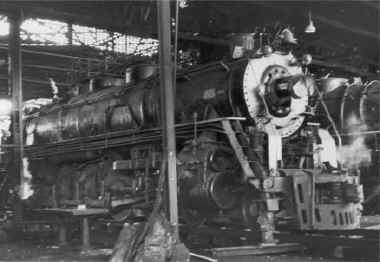 |
|
NdeM 3052 On call 24/7, like several of her neighbors. |
Half of the roundhouse had been converted for diesel maintenance with the addition of walkway level ramps and hose reels for engine lube oil, Journaltex, and premixed coolant. This half of the building was empty while stalls 18 through 32 were still busy with the day to day routine of steam locomotive inspections, service, and running repairs. At this time there was also a little deadwork still being done, and Niagara 3036 rested on blocks in her stall while her drivers were shaved in the machine shop. Of course it wasn't like the old days. That ended in 1964, when most of the older classes were phased out. This would include tank engines, switchers, moguls, ten wheelers, consolidations, mikes (some ex-Nickel Plate), mountains (ex-Florida East Coast), pacifics, hudsons, USRA 2-6-6-2s, and Mexico's own unique design 4-8-0s. In the time that 3049 and 3029 had been serviced, there would have been another dozen or two engine movements in that shop. Now the last 4-8-0 sat cold in the last stall, in the middle of an annual that never got finished. In stall 20 was 2-8-0 #1140 all painted up fancy and shiny. She was being held for preservation and is now displayed in Torreon. Recently out of service, but still full of fuel and water, were Nacional de Tehuantepec Kitson inside connected 0-6-0T 504 and the rather odd looking ex-narrow gauge NdeM 0-8-0T 639. Both of these engines have now also been preserved
I was too young to know anything about how railroads are organized, and never thought to collect data on how many engines were still in service at the time of my visit. I would guess that at least a dozen 4-8-4s were still being used regularly, and that number could well have been higher. They were in helper service, hauled work trains, three engines covered a regular turn that serviced the cement plant at Nochistongo, and a couple were on call 24/7 for standbys. This included passenger service --- several people have told me about riding the international Pullman train, The Aztec Eagle, and watching a steam helper push right behind the observation car !!! On other occasions, a Niagara could haul a failed diesel and it's train NO PROBLEM. At the time I thought I was very fortunate to see them, and I still think so today.
Anyhow, the 3030 was up next. She had been stored in the roundhouse on shop steam, but the hostlers lit her off, ran her out, topped up the fuel, water, and sand, gave her a grease job, then put her away inside again. Just as on the narrow gauge, everything got quiet and still around noon. We went over to a little company run loncheria that the engine crews used, a small cafeteria featuring Mexican junk food. It was there of all places that I heard the Beatles Yellow Submarine for the first time. Of course, the irony of this was not completely lost on me as a single moaning whistle note penetrated the room, letting everybody near the tracks know that the age of steam was not quite over yet.
The whistle belonged to Niagara 3040. It was made from a piece of 5" superheater flue stock and had a deep tone resembling that of UP 844. Most of the other Niagaras had chime whistles, while the smaller brass single note whistles were typical of most other Mexican steam classes. By now the clouds had burned off and the afternoon dust storms hadn't yet started. I was able to get some very nice views of the hostlers waking up 3040 and preparing her for immediate call. This turned out to be for helper service, which began with a light move northbound out of Valle de Mexico. We foolishly hired a cab and tried to follow the engine, but our Spanish wasn't cutting it. We got way out in the boonies on a bumpy, rocky, tiny little dirt road in the vicinity of Huehuetoca, and ran into a little mud shack with a makeshift gate blocking our path. Although it only required a dab of money to clear the way, there was a delay while we haggled. We could see the smoke moving along the horizon and hear the single low wail now and then, and a light fast chuffing exhaust. We nearly got to the track in time, but I wasn't used to the altitude and couldn't run fast enough to position myself for a picture. What I saw was spectacular, though ---- As the 3040 accelerated in a cloud of dust, she was passed by another light engine, southbound sister 3039 returning from a helper shift.
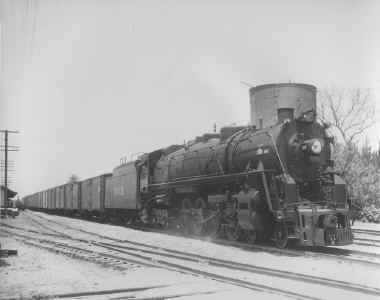 |
|
NdeM 3039 southbound in this view at Queretaro taken by the depot just a few years before my encounter with her in 1966. Photo by C. W. Whitbeck from the collection of Sammy King. |
Huehuetoca is so called because it was a place where the Indians in ancient times gathered to play the Huehue, a native percussion instrument made from gourds which has a tone resembling that of Maracas. This spot was favored because of it's location between vertical rock walls, which lent lively echoes to the tribal music. Next to the water tank the two engine crews exchanged greetings, one with a hooter and the other with a big chime whistle. At that point we gave up chasing after photos and just listened to the echoes bounce back and forth in the valley for awhile as the engines worked farther and farther apart, and their two different whistles sang out for all the grade crossings. 38 years later I realize that I would have spent my time much better if I had simply stayed on one of the engines with the crew and ridden along with them all day rather than running around in circles like a crazy gringo tourist.
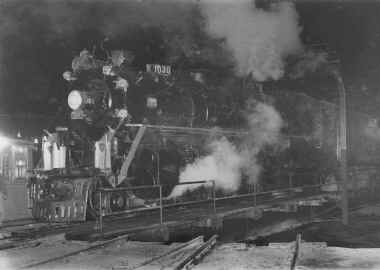 |
|
|
It was dark and we were exhausted when we got back to the yards, but I had to go back over to the roundhouse to see what I could see. 3039 had come in already, and was hooked up on shop steam in the house. 3030 had gotten a call and was being brought out again, while now famous 3038 was waiting her turn on the table and an empty stall. Then the 3054 was brought out. I tried a few pictures, and we called it a day and caught the bus back to town. As our bus got close to Buenavista, we heard yet another Niagara leaving the station compound and whistling like her life depended on it. Even though I hadn't made the best possible use of my time, it was still a fantastic day of steam railroading for me.
|
|
|
NdeM 3054 Headed north out of the roundhouse, another Niagara covers another helper turn on the night of November 25, 1966. The Spanish railroad slang word for helper is maroma, meaning summersault. |
November 26, 1966 was a day I shall never forget. It had begun with my introduction to genuine narrow gauge railroading in Terminal San Lazaro, the ancient FCI station, yards, and shops. Around lunch time, we decided to return to Valle de Mexico while the employees ate and the engines sat. I remember that it was a quiet but very sunny afternoon. I tried a few pictures inside the roundhouse, and wandered about the place pretty thoroughly entranced. In general I'm not a terribly lucky fellow, but now and then on rare occasions the heavens smile on me. That is exactly what happened on November 26, 1966.
By now I was beginning to catch on a little bit as to how things worked in a roundhouse. When the hostlers disconnected the stationary steam from 3040 and bumped up her fire, I had a pretty good idea what was coming next. I climbed up on the last tender in the house and waited for my picture. As it turned out, my lens was too long for the location, so I went out to the lead tracks for a better angle. One thing led to another, and I ended up at the sand tower taking shade alongside the hostlers while the sandbox filled up. Being too ignorant to realize that I could have taken more pictures while the engine backed up toward the roundhouse in the sparkling sunlight, I decided to ask the crew if I could ride the half a mile or so with them. My Spanish was less than awful, and they were most friendly even though they misunderstood my request.
Taking their nods and smiles for a yes, I climbed the ladder, grabbed a piece of waste, and wiped the grease off my hands like I had seen them do it. The hostler and his helper got on, but rather than taking their seats, they indicated that I should sit down on the right hand seat box instead of riding the gangway. Even though I was only 14, I had already devoted a fair amount of time to reading steam locomotive engineer's manuals and air brake books, and had absorbed a lot more from them that I had from my Spanish classes (or much of anything else) in school. The hostler pointed at the whistle chord, which I pulled; the independent brake valve, which I released; the reverse handle, which I shoved toward the tender; and the throttle, which I opened. The engine shivered as 250 pounds of steam forced the throttle valve open, and I leaned in to keep her from opening herself up all the way !!!! We started backing up the way we had come, and they motioned me to cut off, then pointed at the brake handle. Somehow we stopped within reach of the oil standpipe, and I stayed put while the crew filled the bunker. Then the sequence was repeated and we took water. I was really living then, and the thought crossed my mind that I wanted my picture taken at this most wonderful of all life's moments.
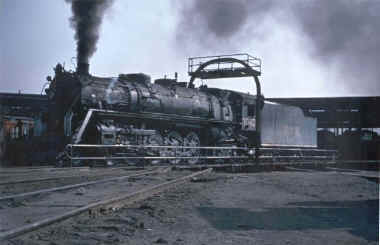 |
|
I admit this is overkill, but I still enjoy these pictures. Please bear with me, I have no other stories like this one to tell. |
By the time the tender was topped off, my ass had been glued to that
seat box for a good half hour. Then the signal came to back up again,
and I gently eased her onto the table. Positioning had to be more
precise than the last two stops I made because the turntable needs to
balance the weight it bears. I dinkied back and forth a few times,
blasting the turntable operator with 3040's open cylinder cocks. I
remember looking down from the cab window and thinking that the bottom
of the turntable pit was a long way down. Finally we turned so my side
of the engine faced the sun, and then I saw Joe up on the tender of a
sister Niagara in the roundhouse. Fortunately he was prepared with the
right camera gear for a perfect series of pictures commemorating the
occasion. Of course, I had to park her in the roundhouse, which I
somehow managed OK.
That's about all I can recall of that particular day. Certainly I
remember what matters most to me, and I have naturally forced countless
friends and acquaintances over the years to look at the pictures of me
driving the 3040, and made them listen to me brag about it. Of course,
if I had been smarter I would have gone back to Mexico again before
steam was finished. But that was back when I believed in railfan
magazines, which missed most of the last steam workings in the places
where I've had my best adventures. I thought that everything vanished
the day after I got back to the states. How was I to know that some of
the Niagaras would run for another year and a half, or that the
NdeM narrow gauge would be using a few steam engines for five years or
more ??
Over the next twenty years I heard no news from Mexico, but I occasionally met somebody who had been there in the sixties and had an experience similar to mine. By 1986 I had been hostling for Burlington Northern for seven years, based out of the BN 23rd St roundhouse in Denver. A fair amount of the other workers were train freaks, too, and they put me in touch with Cliff Prather and Ed Von Nordeck, two Americans with strong ties to Mexico and a great deal of knowledge about the railroads there. Somehow or another I got involved with Sundance Publications about the time they were preparing the Railroads in Mexico books by Francisco Garma Franco, and they put me in touch with Hector Lara, who was also to help me immeasurably when I went hunting for Mexican steam in 1986.
|
The notorious scrap yard at Huehuetoca, considered impossible to enter. A lot of steam engines checked in, only a very few ever checked out..... Niagara 3056 had lots of company in squalor, including the 3040, 1150, and NdeT 504, all now preserved. Photo by Arquitecto Esteban Walker from the collection of Sammy King. |
My priority was to find out what happened to the 3040, as well as her sisters. My sources told me she was in the scrap yard at Huehuetoca, along with five other Niagaras, and that the 3038 was in Mexico City's Chapultapec Park, while 3039 was derelict in the yards at Valle, and 3034 was parked ready to go in the roundhouse. That was good enough for me. My explorations began in the 12 story NdeM office building across from Buenavista station, where I obtained the customary letter of permission and bus pass.
|
NdeM 3038 preparing to leave Buenavista on the morning of November 28, 1982 with the last of her passenger excursions. This engine is now in the National Museum of Technology in Chapultapec Park. Three photos by Ingenerio J. E. Artigas. |
| On July 10, 1968, 3038 had been the last Niagara to perform revenue service, with one final trip to the cement plant in Nochistongo. |
| Climbing the loops to Huichapan, Hidalgo, Niagara 3038 hauls two GP-38s and the train upgrade just for old times sake. Diesels were there for insurance, but photographers who couldn't fit on the head end made good use of the walkways. |
The next stop was Buenavista, which hadn't changed since steam days from what I could tell. I caught the shuttle, got off at the yard office in Valle, and followed the same path I had walked 20 years before over to the roundhouse. Again, very little had changed other than motive power. The NdeM at that time resembled the American railroads as I knew them back in the 60's, while our railroads at home had already mostly done away with ALCOs, passenger trains, 40 foot boxcars, and all too soon would get rid of cabooses as well. I also like diesels, and Valle was still an ALCO paradise at that time with many active examples of both 4 and 6 axle models.
However, I was there to see the Niagaras. This time the roundhouse
was pretty much full. There was a lot less activity inside the
building than there was in the old days, and many more engine movements
outside. Only two stalls lacked the walkway high ramps, and these were
occupied by the mogul 650 and by Niagara 3034. The back end of the
building still had most of the machinery and tools for steam repairs,
and I lingered for some while thinking about my first time there. I saw
the 3038 in the park, painted very nicely but suffering the effects of
standing outside in the elements. 3039 looked like she had provided
parts for the two operable members of the class.
I didn't get to see the 3040 on that trip, but soon after I saw her from
the vestibule of the overnight train from Guadalajara as we sailed past
the scrap yard. She looked awful, but still had the same whistle I
remembered from November 26, 1966. On any number of occasions after
that, I tried to get permission to enter Huehuetoca and somehow buy
3040s whistle, but without success. I will say that while the NdeM never
granted my request, they always gave me some kind of nice souvenir or
treated me to something special, and in general recognized and
encouraged my interest in Mexican railroad history, as well as
tolerating me very good naturedly.
|
|
|
NdeM 3034 in a snapshot given to me by Sergio Coello, taken the last time a Niagara was fired up. Everybody brought their camera to work that day. |
I missed all the modern day excursions using either one of the
Niagaras. My friends gave me some pictures of the last time that either
of the two engines were used, and said that they wished they could have
been where I was on November 26, 1966. Then the late Sergio Coello
called me in Denver one night and said that the 3034 was to be fired up
the next weekend and that I could ride the cab if I could get there. Of
course I got there. We went to the roundhouse and I watched her crew
hook up the compressed air line to her firing manifold and cut off the
protective grates which were welded to her gangway and cab windows. Then
they lit her off. Patiently I sat on the ramp as the pressure built
slowly. The sun came out nicely, and the workers laughed and joked
constantly as they busied themselves installing the wrist pin on the
fireman's side. Obviously they had done it many times before, and their
display of speedy, safe teamwork took me right back in time. There is no
question that full time experienced pros know the steam locomotive
business better than hobbyists ever will.
My luck wasn't as good as it had been twenty years earlier. Somebody
came over from the yard office and tapped the lead man on the shoulder
and said something to him, then all the laughing and joking abruptly
stopped. One of the guys came over to me and told me in Spanish that the
excursion was canceled. I couldn't believe it, but the message gradually
sank in as the guys sullenly disconnected the air and welded the grates
back up where they had been. Nobody said a single word as we gathered up
our stuff and left the roundhouse. At times like that, Tequila is the
only thing that helps.
Now the 3034 is displayed in all her splendor at the national railway museum in Puebla. As far as I know, she never ran again. Of course I still hope that someday she might. 3038 would also be beautiful to see running if conditions were to ever again be right for it. 3040 was taken out of the scrap yard and moved to Oriental en route to her new owner, the Museum of Technology in Jalapa, Vera Cruz. It is felt that the tracks between Oriental and Jalapa will not support her weight, so she is stored in the yards until something can be done. Time has been hard on 3040. Her jewelry and many of her vital parts are missing, and my hope that they are in safe storage is almost certainly unrealistic. And, while I should know better, I still can't help thinking that she is parked on live rail near a shop with oil, tools, water, electricity, and compressed air. I can't help thinking that with so many other Niagaras still around, that maybe somehow the parts could be found to make 3040 run again. At least she still has her whistle.
